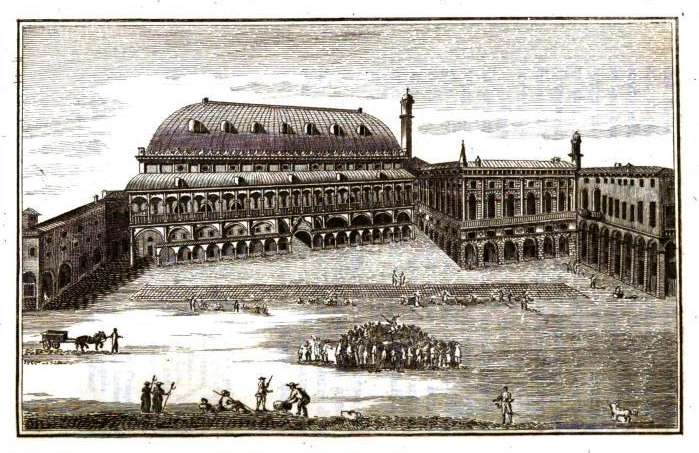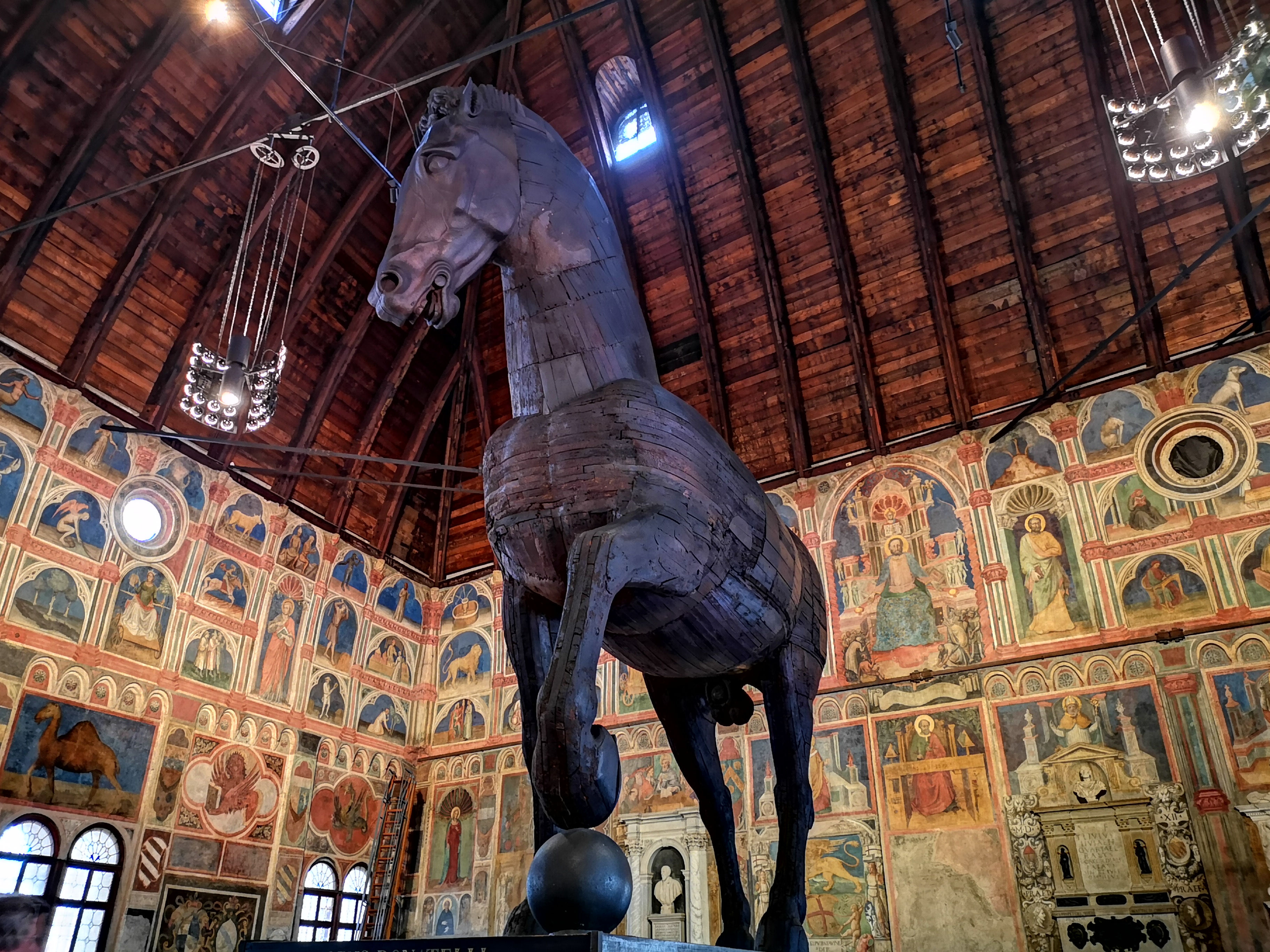|
Piazza Delle Erbe, Padua
Piazza delle Erbe is one of the many squares in the historic center of Padua. For centuries, with Piazza della Frutta, it was the commercial center of the city. In the two squares is one of the largest markets in Italy. Unlike Piazza dei Signori, the civic theater of celebrations, Piazza delle Erbe was the site of the folk festivities. The square is dominated by the imposing Palazzo della Ragione. History The area was active in pre-Roman times. By the time of Imperial Rome, homes gave way to businesses. Its present design is from the tenth and eleventh centuries. The space was occupied by a number of shops and stalls selling all kinds of goods, from the edible to luxury goods. With the construction of the Palazzo della Ragione in the early thirteenth century that areas were assigned to specific types of goods. In the hall sellers of fabrics and furs. At the foot of the staircases around the building were the awnings for iron (Scala del Feri, to the east) and wine (Scala del Vi ... [...More Info...] [...Related Items...] OR: [Wikipedia] [Google] [Baidu] |
Padova Juil 09 288 (8187574033)
Padua ( ; it, Padova ; vec, Pàdova) is a city and ''comune'' in Veneto, northern Italy. Padua is on the river Bacchiglione, west of Venice. It is the capital of the province of Padua. It is also the economic and communications hub of the area. Padua's population is 214,000 (). The city is sometimes included, with Venice (Italian ''Venezia'') and Treviso, in the Padua-Treviso-Venice Metropolitan Area (PATREVE) which has a population of around 2,600,000. Padua stands on the Bacchiglione River, west of Venice and southeast of Vicenza. The Brenta River, which once ran through the city, still touches the northern districts. Its agricultural setting is the Venetian Plain (''Pianura Veneta''). To the city's south west lies the Euganaean Hills, praised by Lucan and Martial, Petrarch, Ugo Foscolo, and Shelley. Padua appears twice in the UNESCO World Heritage List: for its Botanical Garden, the most ancient of the world, and the 14th-century Frescoes, situated in different bui ... [...More Info...] [...Related Items...] OR: [Wikipedia] [Google] [Baidu] |
Piazza Dei Signori, Padua
Piazza dei Signori is a city square in Padua, region of Veneto, Italy. This piazza for centuries hosted official civic and government celebrations, while the larger squares of Piazza delle Erbe (herbs) and Piazza della Frutta (fruits) hosted commerce and public festive celebrations. The square is dominated by the famous Clock Tower. History The square arose in the fourteenth century with the demolition of an old district that stretched in front of the church of San Clemente, promoted by Ubertino from Carrara. The square was designed to give importance to the tower and access to Palace on the east side, that he was building. It became the scene of tournaments and courtship. According to tradition it was from the ''noblemen'' or ''signori'' Carrara that the square took its name. The 14-century war between the Carrara and the Visconti damaged the square and surroundings buildings and is called the period "of Desolation". The arrival of Venetians rule restored the square as the f ... [...More Info...] [...Related Items...] OR: [Wikipedia] [Google] [Baidu] |
Palazzo Della Ragione, Padua
The Palazzo della Ragione is a medieval market hall, town hall and palace of justice building in Padua, in the Veneto region of Italy. The upper floor was dedicated to the town and justice administration; while the ground floor still hosts the historical covered market of the city. The palace separates the two market squares of Piazza delle Erbe from Piazza dei Frutti. It is popularly called "il Salone" (''the big Hall''). It is part of the UNESCO World Heritage Site of Padua's 14th-century fresco cycles (since 2021). Details The building, with its great hall on the upper floor hence the name "Salone" ("big Hall"), is believed to be one of the largest medieval halls still extant; the hall is nearly rectangular, its length 81.5m, its breadth 27m, and its height 24 m; the walls are covered with allegorical frescoes. The building stands on arches, and the upper storey is surrounded by an open loggia, not unlike that which surrounds the Basilica Palladiana in Vicenza, that was ... [...More Info...] [...Related Items...] OR: [Wikipedia] [Google] [Baidu] |
Piazza Erbe 1817
A town square (or square, plaza, public square, city square, urban square, or ''piazza'') is an open public space, commonly found in the heart of a traditional town but not necessarily a true geometric square, used for community gatherings. Related concepts are the civic center, the market square and the village green. Most squares are hardscapes suitable for open markets, concerts, political rallies, and other events that require firm ground. Being centrally located, town squares are usually surrounded by small shops such as bakeries, meat Meat is animal flesh that is eaten as food. Humans have hunted, farmed, and scavenged animals for meat since prehistoric times. The establishment of settlements in the Neolithic Revolution allowed the domestication of animals such as chic ... markets, cheese stores, and clothing stores. At their center is often a water well, well, monument, statue or other feature. Those with fountains are sometimes called fountain square ... [...More Info...] [...Related Items...] OR: [Wikipedia] [Google] [Baidu] |
Imperial Rome
The Roman Empire ( la, Imperium Romanum ; grc-gre, Βασιλεία τῶν Ῥωμαίων, Basileía tôn Rhōmaíōn) was the post-Republican period of ancient Rome. As a polity, it included large territorial holdings around the Mediterranean Sea in Europe, North Africa, and Western Asia, and was ruled by emperors. From the accession of Caesar Augustus as the first Roman emperor to the military anarchy of the 3rd century, it was a Principate with Italia as the metropole of its provinces and the city of Rome as its sole capital. The Empire was later ruled by multiple emperors who shared control over the Western Roman Empire and the Eastern Roman Empire. The city of Rome remained the nominal capital of both parts until AD 476 when the imperial insignia were sent to Constantinople following the capture of the Western capital of Ravenna by the Germanic barbarians. The adoption of Christianity as the state church of the Roman Empire in AD 380 and the fall of the Western R ... [...More Info...] [...Related Items...] OR: [Wikipedia] [Google] [Baidu] |
Palazzo Del Podestà, Padua
A palace is a grand residence, especially a royal residence, or the home of a head of state or some other high-ranking dignitary, such as a bishop or archbishop. The word is derived from the Latin name palātium, for Palatine Hill in Rome which housed the Imperial residences. Most European languages have a version of the term (''palais'', ''palazzo'', ''palacio'', etc.), and many use it for a wider range of buildings than English. In many parts of Europe, the equivalent term is also applied to large private houses in cities, especially of the aristocracy; often the term for a large country house is different. Many historic palaces are now put to other uses such as parliaments, museums, hotels, or office buildings. The word is also sometimes used to describe a lavishly ornate building used for public entertainment or exhibitions such as a movie palace. A palace is distinguished from a castle while the latter clearly is fortified or has the style of a fortification, whereas a ... [...More Info...] [...Related Items...] OR: [Wikipedia] [Google] [Baidu] |
Gian Galeazzo Visconti
Gian Galeazzo Visconti (16 October 1351 – 3 September 1402), was the first duke of Milan (1395) and ruled the late-medieval city just before the dawn of the Renaissance. He also ruled Lombardy jointly with his uncle Bernabò. He was the founding patron of the Certosa di Pavia, completing the Visconti Castle at Pavia begun by his father and furthering work on the Duomo of Milan. He captured a large territory of Northern Italy and the Po valley. He threatened war with France in relation to the transfer of Genoa to French control as well as issues with his beloved daughter Valentina. When he died of fever in the castello of Melegnano, his children fought with each other and fragmented the territories that he had ruled. Biography During his patronage of the Visconti Castle, he contributed to the growth of the collection of scientific treatises and richly illuminated manuscripts in the Visconti Library. Gian Galeazzo was the son of Galeazzo II Visconti and Bianca of Savoy. H ... [...More Info...] [...Related Items...] OR: [Wikipedia] [Google] [Baidu] |


.jpg)



